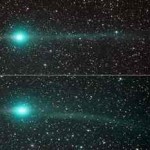
Digital News Report- A new Comet has been discovered that is visible to the naked eye. Comet Lulin, aka Comet C/2007 N3, is a non-periodic comet that was discovered by Ye Quanzhi and Lin Chi-Sheng from Lulin Observatory. It’s peak brightness for observers will be on February 24th. It will come within 38 million miles of Earth at its closest pass.
Astronomer Lin Chi-Sheng first photographed the comet with a 16-inch telescope at the Lulin Observatory in Nantou, Taiwan on July 11, 2007. Quanzhim, a 19-year old college student from Sun Yat-sen University in China, identified the new object from three of the photographs taken by Lin.
On February 4, 2009, a team of Italian astronomers witnessed “an intriguing phenomenon in Comet Lulin’s tail.” Ernesto Guido, the team leader, said, “Our images clearly showed a disconnection event. While we were looking, part of the comet’s plasma tail was torn away.” Guido and colleagues believe the event was caused by a magnetic disturbance in the solar wind hitting the comet.
Comet Lulin is also unique due to its clockwise path around the sun. During its journey around the sun, it will shed nearly 800 gallons of water each second. That will equal about one Olympic sized swimming pool every fifteen minutes.
Using the Swift Telescope, astronomers from NASA and the United Kingdom will study the comet and its composition. Astronomers also say to see it while you can because this could be the first and only time it passes through our solar system and if it does return, it may not be for over 1,000,000 years.
“We won’t be able to send a space probe to [the comet], but Swift is giving us some of the information we would get from just such a mission,” said Jenny Carter, at the University of Leicester in England, who is leading the study.
The best time to view the comet is around 1:00am when it is the highest in the sky. It will be due south near Saturn moving towards the west. However, dark skies are required. However, NASA stated, “no one can say for sure. This appears to be Lulin’s first visit to the inner solar system and its first exposure to intense sunlight. Surprises are possible.’
